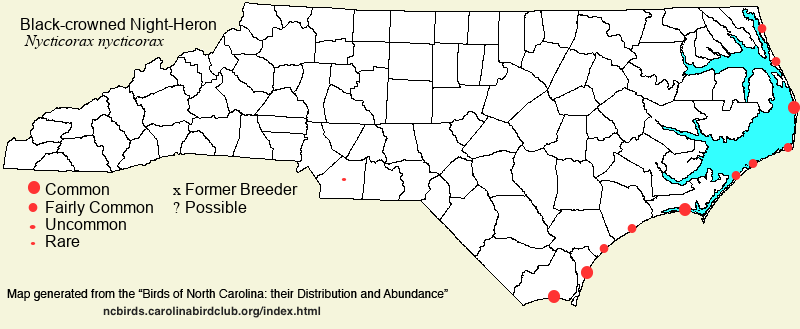 |  |
|
Black-crowned Night Heron - Nycticorax nycticorax ARDEIDAE Members: | Search Common: Search Scientific: |
|
|
||||||
| General Comments |
The Black-crowned Night Heron is our only truly nocturnal waterbird. Birds roost in thickets, usually close to water, during the day, and emerge at dusk to fly to favored foraging sites. As the species is primarily coastal, it most often forages along tidal creeks, pools, and mudflats, but birds also forage around brackish water and at coastal freshwater ponds. It nests on coastal islands with other wading birds; not until 2008 was the species found nesting away from tidal water (Columbus), even though the species nests well inland in many other Eastern states. A pair (or two) was presumed to have nested in the Piedmont, in Union County, in 2022 and again in 2023. It does migrate through inland portions of the state, but its nocturnal nature means that few birds are actually encountered. One potential problem with record-keeping is that immatures of this species and Yellow-crowned Night Heron can be confused; thus, a few reports of such birds (especially inland) might well be mis-identified. Numbers of breeding pairs have slowly declined in recent decades, but not so much as to have the species listed as State Special Concern.
NOTE: In 2024, the AOS removed the hyphen between the words "Night" and "Heron" in this species' name and in the Yellow-crowned Night Heron. | |||||
| Breeding Status | Breeder | |||||
| NC BRC List | Definitive | |||||
| State Status | W | |||||
| U.S. Status | ||||||
| State Rank | S3B,S3N | |||||
| Global Rank | G5 | |||||
| Coastal Plain | Permanent resident coastally, and a transient inland. Along the coast, fairly common to locally common all year, though there is some migration; one of the more numerous of the wintering waders, but not easily seen except in flight at dusk or at known roosting sites. Generally rare to uncommon in the Tidewater zone, most frequently seen along the shores of Pamlico Sound (mainland). Farther inland, a very rare or poorly known migrant, most often from early Apr to mid-May. Unusual was as many as seven birds that overwintered in 2006-07 [7 Dec to 17 Feb] at far-inland Goldsboro. Another notable inland winter record was four seen on both 3 Jan and 7 Feb 2025 at a pond in Kenansville (Duplin). Peak counts: | |||||
| Piedmont | Transient and post-breeding visitor; accidental breeder (in 2022-24). Rare and secretive, mostly in Apr and May, and again from late Jul to mid-Sep; casual to very rare in winter, with just a few records. A report of four, with at least two juveniles, at Jordan Lake (Chatham), 8 Jul 2018 raises the possibility of local breeding. In 2022, several adults and recently-fledged juveniles were seen with adults at Lake Twitty (Union), with a count of four adults and two juveniles noted on 13 Jun [Chat 86:102 link]. Though no nest was found, the evidence does seem to indicate this as being the first breeding record for the province. Similar results from that lake were noted in 2023, with at least five adults and three immatures on various dates from Jun-Aug. In 2024, two adults and one of undetermined age were seen on 9 Jul, likely breeding birds. Peak counts: 8, Bunn Lake near Zebulon (Wake), 23 Sep 1991; 8, Lake Twitty (see above), 23 Aug 2023; 6, see above; 5, Jordan Lake, 17 Sep 2005. | |||||
| Mountains | Transient and post-breeding visitor. Rare at low elevations in the southern counties; very rare in the central and northern mountains. Generally from early Apr to mid-May, and mid-Jul to mid-Aug. The only known record between mid-Sep and early Apr is an adult photographed at Beaver Lake (Buncombe), 18-19 Dec 2019. Peak count: 2, on four dates. | |||||
| Finding Tips |
This species is usually found along the coast at any season, but you might need to wait around tidal mudflats and marshes until dusk, when the birds fly from their roosts to the flats. Roosting birds can at times be seen sitting quietly in shrub thickets. At any rate, you are not likely to see the species feeding in the open during daylight hours. The species is too rare inland to search for intentionally. *** | |||||
| Attribution | LeGrand[2025-05-08], LeGrand[2025-02-03], LeGrand[2024-11-04] | |||||
| NC Map Map depicts all counties with a report (transient or resident) for the species. | Click on county for list of all known species. |
| NC Breeding Season Map Map depicts assumed breeding season abundance for the species. |  |